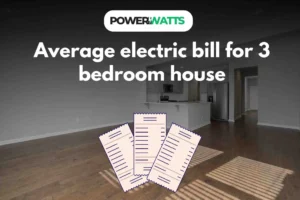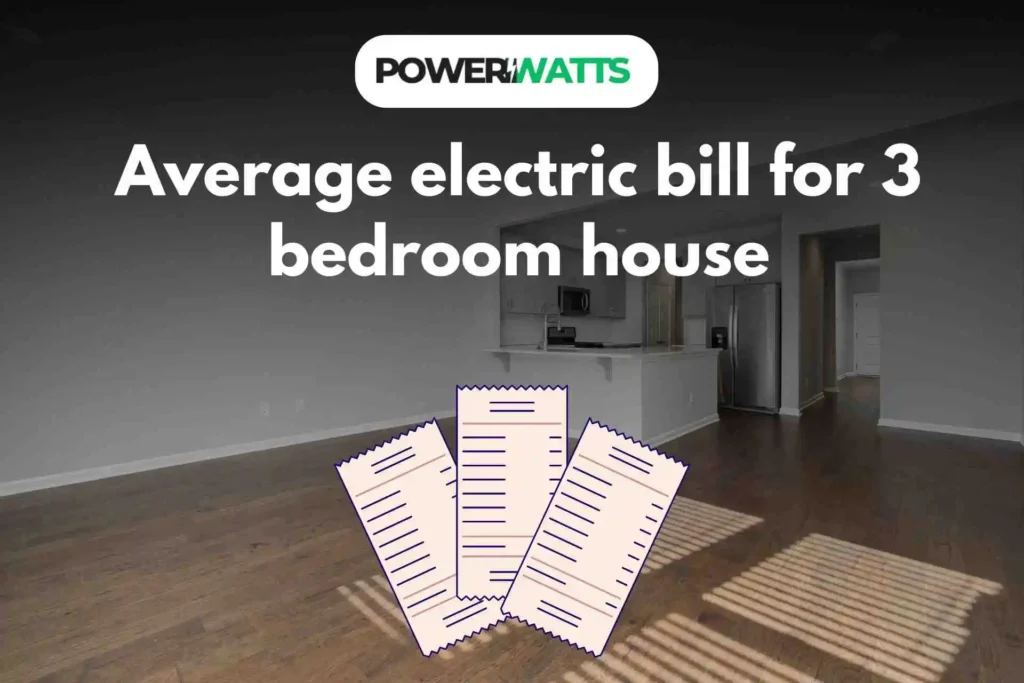Electricity cost contributes to one of the major components in the budget is the average electric bill for 3 bedroom house. The cost of electricity to you is based on several factors: the size of a house, the number of occupants, the efficiency of appliances, and the local climate.
In the discussion below, we explore the average electric bill for a 3-bedroom house, have a closer look at the influential factors that come with energy costs, and share tips on how to reduce your expenses on electricity.
Average Electric Bill for 3 Bedroom House
It is very different to quote an average electricity bill for a 3-bedroom house in the United States, as it would be very dependent on the region, season, and consumption of a household. However, for rough estimation purposes, here is a guess:
- National Average: $100-$150 per month
- High-Use Regions: $150-$250 per month—particularly regions with extreme temperatures
- Low-Use Regions: $75-$100 per month—usually for countries with mild climates
These figures are just the average costs for a 3-bedroom house with average energy consumption. Remember, electricity rates vary from state to state and can change with different utility providers; thus, this number can be even higher or lower than your current bill.

Factors That Influence Electric Bills in a 3-Bedroom House
A number of factors play an important role in determining how much you need to pay toward electricity each month. Knowing these factors can help you move in the right direction for better energy consumption.
House Size and Layout:
The other factor that could influence the energy standards is your house’s size and design. A big house requires more energy consumption for heating, cooling, and lighting. In addition, open-plan houses tend to lose heat or cool down faster. This will lead to using energy more than typically needed.
Number of Occupants
The number of occupants in the house determines energy consumption because their actions cooking, heating water, operating appliances, and electronic gadgets require more electricity. Of course, each added occupant contributes to the aggregate consumption of energy.
Climate and Seasonal Variations:
If the heating and/or cooling costs are a major factor, much can be placed on the efforts of heating and cooling costs in the local climate. In general, these types of climates can make a significant portion of your electricity bill due to heating and cooling. For instance, when it gets really hot during the summer, sometimes air conditioning units run all day, which increases energy consumption tremendously. In contrast, electric heat can be very expensive when living in colder climates, especially in the winter.
Energy Efficiency of the Home:
Energy efficiency in homes, with regards to proper insulation, energy-efficient windows, and modern HVAC systems, is associated with lower electric bills. These features cut down on the consumption of energy required to maintain comfort inside the home.
Appliance Efficiency:
Your electrical bill depends vastly on the age, efficiency, and state of the appliances you use. Generally speaking, older models are more prone to chew up electricity; almost all that are not Energy Star take up much more power compared to new ones. Quite a large amount of money can be saved through shifting towards energy-efficient models.
Electricity Rates:
Electricity rates vary further depending on your state, utility company, and even time of day. Generating and distributing costs associated with electricity result in far higher rates for some regions compared to others. Other areas may be offered at substantially lower rates, with a discount depending on a person’s usage during times of lesser demand. Knowing your local electricity rate will help you find ways to save.
Usage Patterns
Other daily habits and routines can affect your electric bill as well. These include, but aren’t limited to, leaving lights on when not in use, running half-loads in the dishwasher, or using high-energy appliances during peak hours.
Regional Difference in Electric Bills
Electricity bills are very different depending on what region you are dwelling in. Here are just a few examples of what average electric bills look like in different parts of:
Northeast:
Electric bills in the Northeast regions tend to be high, especially for homes due to the cold winter seasons, as energy consumption for heating is usually high. An example cost for the average electric bill in a 3-bedroom house could be about $150 to $200 during the winter season.
Southeast:
During the Southeast summers, smothered by heat and humidity, air conditioning accounts for the lion’s share of high electric bills. Therefore, the average bill can easily jump from about $130 up to approximately $250 per month and higher in the summer months.
Midwest:
The Midwest experiences cold winters and hot summers, making the electric bill sometimes significantly different throughout the year. On average, it usually settles between $120 and $180 a month.
West Coast:
On the West Coast, especially in California, some of the highest electricity rates make this state seem to be one of the most expensive in terms of payables. Because of the mild climate, the bill is usually between $100 and $150 per month.
Southwest:
The hot and dry climate of the Southwest has translated to a very expensive venture in keeping cool through air conditioning, especially during summer. For example, the average bill for a 3-bedroom house in this region can stand at $130 to $200 monthly.

How to Lower Your Electricity Bill
Whichever region you live in, there are several ways through which to lower your electric bill. Here are some effective tips that help you save money on electricity bills:
Update to Energy-Efficient Appliances
Upgrading to new Energy Star-rated appliances instead of the ugly, old, inefficient models can greatly reduce your energy use. Consider upgrading your fridge, dishwasher, clothes washer, and HVAC system with higher-efficiency units.
Better Insulating for Your Home:
Proper insulation will also keep your home warm during winter and cool during summer, hence reducing the needs for heating and cooling. Seal draughty areas around windows and doors; consider adding insulation to your attic or walls.
Programmable Thermostat:
A programmable thermostat allows you to set specific temperatures at different times of the day so that energy is at a minimum when one is not home or during sleep. For example, you can set the thermostat to lower the temperature at night or when the house is empty.
Optimise Lighting:
Replace incandescent bulbs with energy-efficient LEDs or CFLs. These bulbs steadily use less energy and have longer lifespans, hence saving on replacement costs. It has also been part of turning off lights when there is no one in the room.
Peak Usage Management:
Some utility companies will charge you at a higher rate depending on the time of day. To save on your electric bill, look to operate high-energy appliances, like dishwashers and washing machines, during low-demand hours. Check with your utility provider to see if they offer time-of-use rates and how you can take advantage of them.
Unplug Devices When Not in Use:
Such a large amount of electronic equipment turns on, even while it is turned off. This “phantom” energy usage can be prevented by unplugging the devices or having a power bar in which one can easily switch off.
Systematic Maintenance of HVAC System:
Keep your heating and cooling systems running efficiently by scheduling regular maintenance. Replace air filters regularly, and have your HVAC system serviced annually to ensure it operates at peak efficiency.
Consider Renewable Energy:
Some of these electricity costs can be defrayed with solar panels or community solar programs. Although the upfront investment may be very high, potential long-term savings and environmental benefits could also be great.
Evaluate your use of energy:
Check your electricity consumption using smart meters or any of the energy monitoring devices on a real-time basis. Use real-time data to make sure that in order to curb your high energy usage at any given time, you get an appropriate change in your consumption habit.
Conclusion
The average bill of electricity for a 3-bedroom house can be such a factor that remains on the broader spectrum scale. The size of a home, number of occupants, efficiencies of appliances, and local climate are some key factors that can influence the bill. While the national average ranges from $100 to $150 per month, learning just exactly what governs what amount you have to pay will better equip you with ways of minimizing your consumption. Make smart upgrades and adopt energy-saving practices that will lower your electric bill and contribute towards a sustainable future.
Get a Quote In case you are interested in integrating an inverter with a solar charger into your power system, do not hesitate to contact us today for your custom quote.


